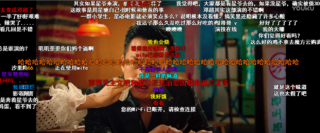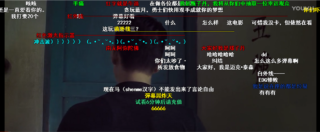October 31, 2017 / Vincent So
Creative Audience Participation Through ‘Danmu’

| Author: | Vincent So (University of Amsterdam) |
“Danmu” (Chinese:弹幕, literally meaning “bullet curtain”) is an online commenting system which allows viewers to post their comments directly on top of the video. Unlike the comment section in western video sites, where comments are shown in a designated space below or aside the video, these Danmu comments generated by viewers (not subtitles or annotations) are projected directly on the screen, floating horizontally through the video, and overlaying the original content. While viewers watch the video, at the same time, they read other viewer’s comments. The Danmu phenomenon trends in multiple East Asian countries. It gained immense popularity in China and has become a default feature in major video sites.
One of the most significant aspects of Danmu is that it challenges the spatial positioning of the traditional comment section layout. The redesigned space undermines the hierarchy within the comment section and the webpage itself. The traditional structure of the comment section originated from the bulletin-board system in the 1980s, where the line-on-line system allows users to read and reply in a fixed and rigid format (James, Wotring, & Forrest 1995). In the traditional design, the comment sections are usually located at the bottom of the Web page (Reagle 2015).
Many studies about online comments assumes separated comment sections placed below the original content. This normative spatial hierarchy of most social media platforms suggests that the comment section is always inferior to the original content. Comments are being seen as “paratext” of the screen (Genette 1997), as semi-textual fragments that surround and position the main text (the streamed video in this case).
The idea of Danmu challenges this existing spatial hierarchy of online commenting. By merging both the original content and the comment section in the same space, Damnu comments are treated to be as equally important as the original content. With the given positioning, screen time, and visibility, Danmu comments have the same level of power and significance communicated across the screen as the original content. Danmu invites audiences to participate and interact through their user-generated Danmu comments, thus creating new creative opportunities and alternative forms of participation.
Here, an example is drawn from the Chinese video streaming site Youku to further illustrate the idea. In Figure 1, it shows a number of Danmu users playing laser tag in a martial art movie (Ip Man 3, 2015) for no reason. A user writes “red laser—–,” which is quickly followed by similar comments of “yellow laser —,” “white laser —,“ and “shock wave)})).” These creative yet “meaningless” interactions among the audience is full of immature humor and repetition, and it is considered by Danmu viewers as part of the fun viewing experience.

Figure 1. Users Playing Laser Tags
As shown in the above example, by playing laser tag, the audience has subverted the original program for a brief moment, challenging the dominant screen presence of the content. These repetitive participation can be deemed as “meaningless” because they have no connection with the content, or reinforce our interpretation of the main text. The spatial freedom of the Danmu system allows the audience to interact with each other through the platform feature, undermining the content at the same time. Comments are no longer just “paratext.” Without referencing to the visual content, the users create their own self-contained narrative within their Danmu participation. It brings in a new relationship between audience and content.
Throughout the research process, it was observed how numerous Danmu comments emphasize they are not here for the original content (movies or TV shows), but the Danmu experience. “I’m here for the Danmu (comments)!” “The Danmu content here is even better than the TV show.” “I just read the Danmu comments and see the diverse views of others.” The popularity of Danmu in China brings in new forms of online viewership and participation. In Danmu, creativity occurs when audiences generate their own narrative, interpretation, and discussion in relation to the video and the social/online context. But most importantly, sharing these thoughts and ideas, and interacting with other viewers, is the key experience for many of these Danmu viewers. This is the Danmu experience they are going for, and it can be only achieved through this unique platform feature.
- Genette, G 1997, Paratexts: Thresholds of Interpretation. Cambridge University Press, Cambridge, New York.
- James, ML, Wotring, CE, & Forrest, EJ 1995, ‘An exploratory study of the perceived benefits of electronic bulletin board use and their impact on other communication activities’, Journal of Broadcasting & Electronic Media, vol. 39, no. 1, pp. 30–50.
- Reagle, JM 2015, Reading the Comments: Likers, Haters, and Manipulators at the Bottom of the Web. The MIT Press, Cambridge, Massachusetts.

